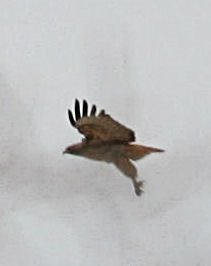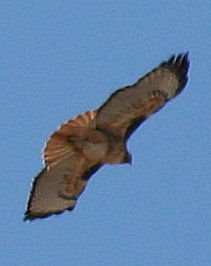I cropped the photo to look at an enlargement of each hawk. I particularly liked the shot of the hawk on the left. With some adjustments in Paint Shop Pro (noted under each photo) and some excellent coaching from OP, I was able to bring out quite a bit of detail. The grey mottling is out-of-focus branches in the foreground.
 Paint Shop Pro: Histogram gamma adjustment, Brightness -15, Contrast +10, High Pass Sharpen
Paint Shop Pro: Histogram gamma adjustment, Brightness -15, Contrast +10, High Pass SharpenI repeated the process with a photo of the other hawk soaring in the clear blue sky:
 Paint Shop Pro: High Pass Sharpen only
Paint Shop Pro: High Pass Sharpen onlyI had never spent any time observing birds nor had I ever photographed birds before I started this blog. Most of the birds I currently photograph are in my own backyard or close by. I'm so grateful for the technology that allows me to have a permanent record of these backyard visitors. I continue to work on mastering that technology.



7 comments:
Excellent description of the process, both the internal (your eyes, your sensitivity), and the external (the camera, and the software). Fantastic shots of those redtails. Beautiful.
We are having similar experiences, pam. I never photographed birds until last year. Being retired has allowed me to slow down enough to really look around. There is so much to see, and the camera has been an incredible extension of what my eyes have been searching for. I like having that permanent record, even if it is on digital!
RD - "... and the camera has been an incredible extension of what my eyes have been searching for." I deleted a paragraph from my post waxing enthusiastic about just this observation, because I wasn't getting the words to work. You've done it for me!
I look forward to May, when we'll both be truly retired and we, too, can slow down and savor our world a little more.
Thanks for sharing your processing of the photos.
I keep working to learn more about editing on the computer but feel as though I am wandering through the woods blindfolded.
Guess this is a new adventure for all of us.
Heres to more adventures and to learning how to use all of this wonderful new technology :)
Yes, we must thank all engineers. They offer so powerful cameras and software to us! To photograph became a play of child.
Oui, nous devons remercier tous les ingénieurs .Ils nous offrent des caméras et des logiciels si performants !
Photographier est devenu un jeu d'enfant .
endment - I continue to learn - one feature at a time. I'm not very systematic about it, I'm afraid. But it's a lot of fun.
jean - When I realize the genius that is behind the camera workings and the software, I am full of respect for the engineers and scientists who produce these for us. Many years ago, I was a designer of telescope lenses and optical accessories for Kitt Peak National Observatory. I have also been a computer programmer. These jobs were difficult for me, yet what I worked on was so much simpler than the designs that go into cameras and software today.
Wow, Pam. It is amazing what you were able to do with the situation and your original images. So interesting and informative.
laura - I'm glad you found it interesting. I hope to become more systematic in learning both camera techniques and photo-processing. In the mean time, when I spot a good photo op. I point and shoot. Since I seem to be taking a lot of photos of moving objects these days, there's a lot of luck involved.
Post a Comment